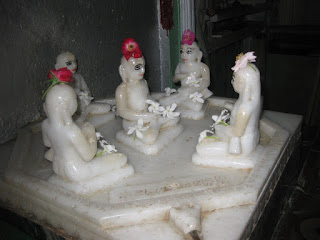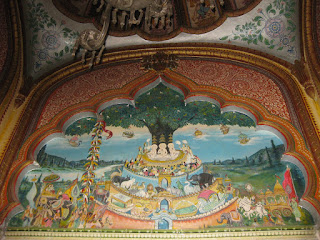The Jain community in India observes Festival of Navpad Oli, that last for nine days, twice a year. (Navpad is also spelled in English as Navapad and Navapada).The first one falls in the bright fortnight of Ashwina month (September/October) and the second during the bright fortnight of Chaitra month (March/April). It is exactly between Shukla Saptami (Seventh lunar day) to Purnima (Full moon day) in both Ashwina and Chaitra months.
Navapad Oli starts in the middle of Navratri, Hindu festival of India. Both of Navapad Oli falls among five Shaswata Atthai of Jain. Rest of three Atthai are Chaturmasik Atthai (Thrice in a year).
Jain performs Ayambil Tapa for nine days to salute these nine supreme posts in the universe. Ayambil (Ayambila) is a special type of fast in that one eats only boiled grains that too once in a day. It is not permitted to add anything including salt to the boiled grains. Hence, it is very difficult for a layman to perform Ayambil Tap.
 |
| Navpad Idol at Vimalnath temple, Jiaganj, Murshidabad |
 |
| Arihant Samavasharan- Mahavira Swami Jain Temple, Kolkata |
Update
Navpad Oli Chaitra and Ashwina 2019
Navpad Oli (Chaitra) will be starting from Thursday, April 11, 2019, and will be ended on Chaitra Poornima, Saturday, April 19 in this year 2019. Similarly, Ashwina Oli will start from October 5 and will be ended on October 1, 2019. Large numbers of Jain devotees are ready to observe Ayambil during the period.
Navpad Oli and seasonal change
The earth moves around the sun and duration of days and nights are constantly changing around the year. Duration of a day and night in India are almost equal during March-April and September-October. These are the days of Navapad Oli. As the duration of days and nights are almost equal, nature lives in equilibrium in these days. These neither are scorching heat nor chill cold. These are also moderate seasons, perfectly suitable for worshiping supreme powers of the universe.
Navapad Oli in Chaitra comes at the beginning of summer and end of the winter. Similarly, Navapad Oli in Ashwina comes at the beginning of winter and the end of the summer. Both seasons are crucial for our mental and physical health. Devotion and Navpad prayer keep us mentally healthy whereas Ayambil (fast) and other penance energize us to fight with diseases and keep us healthy physically.
 |
| Navpad Siddhachakra, Rambagh Jain temple, Azimganj, Murshidabad |
Navpad, Panch Parameshthi, and Siddhachakra Yantra
Nava means nine in Sanskrit and Prakrit languages and Pada means post. Hence the word Navapada (That is generally spelled in English as Navpad) means nine supreme posts of the universe. These nine are Arihant, Siddha, Acharya, Upadhyaya, Sadhu, Samyag Darshan, Samyag Jnyan, Samyag Charitra and Samyag Tapa (Austerity).
Navapad is also called Siddha Chakra. This is a Yantra in a circular shape in that Siddha is placed on the top. Arihant is placed in the center and Acharya at the right side of Arihant. Upadhyaya is placed on the lower side and Sadhu on the left side of Arihant. Samyag Darshan, Samyag Jnyan, Samyag Charitra and Samyag Tapa are placed in four corners starting from the upper right corner and then moving clockwise.
First five posts of Navapad are called Panch Parameshthi where Param means ultimate or supreme and Esthi means to worship. Thus these Panch Paramesthi are the eternal powers to be worshiped. Arihant and Siddha are Deva(God) Tatva and Acharya, Upadhyaya and Sadhu are Guru (Preacher or master) Tatva. Generally, the first five (Panch Parameshthi) are placed in the shape of idols and the next four by name only.
Specialty of Jainism
Jain philosophy does not believe in personifications. The post of God is not reserved for any individual. Jain philosophy declares that anyone can attain any of these supreme posts by means of developing virtues within. It is described in the Jain Agam (sacred texts) that infinite numbers of the soul has attended salvation in the past and will be attending in the future by observing virtues. Some souls are attaining it in present days too.
This is the specialty of Jainism that separates it from semantic and Vedic religions.
Last four pad of Navapad is great virtues. These are depicted as Dharma(Spirituality) Tatva in Jainism. One can attain Moksha (salvation) by observing those virtues. Arihant and Siddha, first two posts in Navapad accomplish these four virtues or attributes. Acharya, Upadhyaya, and Sadhu are in the path of accomplishing these attributes.
Brief description of Navapad: Dev Tatva
Arihant: This is the first post of Navapad and posted in the center of Siddhachakra. It falls among Deva Tatva as described earlier. Arihant is the supreme power of nature. He is the purest soul in the universe with a physical body. Ari means Enemy and Hant means destroyer. Here enemies are internal and these are Raga (Craving or attachment) and Dvesha (Hatred). Hence, Arihant is free from earthly attachments and hatred and referred to as Veetraga. He lives in the world with a physical body in perfect equilibrium. He is also a universal observer having complete wisdom that is Kevala Jnyana (Omniscience).
Arihant is also called Arhant that means worshiped by the whole universe. He has twelve supreme attributes and depicted by the symbolic color white.
As he knows anything and everything in the universe by virtue of his Kevala Jnyana he preaches true spirituality Sitting in a Samavasharan (Picture posted). He also establishes Chaturvidha Sangha, the fourfold Jain Sangh. Sadhu (Male ascetics-Monks), Sadhwi (Female ascetics-Nuns), Shravaka (Household followers, Male) and Shravika (Household followers, female) are the constituents of this Sangha that is also called Teertha. Arihant establishes the Teertha, hence, he is also called Tirthankar.
Jain followers worship Arihant Pada in Shukla Saptami, the first day of Navapad Oli. They perform Ayambil by eating boiled rice only. The color of Arihant is white, hence the grain chosen for Ayambil is white i.e. rice. They also pray, worship and meditate for Arihant during the day.
Siddha: This is the second post of Navapad and posted in the top of Siddhachakra. He also falls among Deva Tatva as described earlier. Siddha is the supreme power of nature. He is the purest soul in the universe without a physical body. One becomes Siddha after attaining salvation. The Siddha is also a Veetraga and universal observer but does not preach because he does not have any physical body. He lives in perfect equilibrium, eternal peace, and joy. He also remains in perfect motionless rest.
Siddha is free from all Karmic bondage and has no reason to live as a mundane soul. Hence, there is no reincarnation. He lives forever above the Siddha Shila at the top of the Universe. He has eight supreme attributes and depicted by the symbolic color red.
Jain followers worship Siddha Pada in Shukla Ashtami, the second day of Navapad Oli. They perform Ayambil by eating boiled wheat only. The color of Siddha is red, hence the grain chosen for Ayambil is red i.e. wheat. They also pray, worship and meditate for Siddha during the day.
Brief description of Navapad: Guru Tatva
Acharya: Acharya is the third post in Navpad and placed in the right side of Arihant in Siddhachakra Yantra. He is the first among Guru Tatva. Acharya is the successor of Arihant and leader of the fourfold Sangh established by the Arihant. He is the Supremo and ultimate decision-making authority in all the matters related to Sangha in absence of Arihant. He is also the ultimate authority in the interpretation of the Jain Agam (Holy Scriptures).
He observes and motivates Monks and Nuns for five spiritual conducts Jnyanachara, Darshanachara, Charitrachara, Tapachara, and Veeryachara. The first four are related to the last four Padas of Siddhachakra. Veeryachara, the fifth is enthusiasm and power to observe these four. Acharya has thirty-six attributes and symbolizes by Golden yellow color.
Jain followers worship Acharya Pada in Shukla Navami, the third day of Navapad Oli. They perform Ayambil by eating boiled gram only. The color of Acharya is golden yellow, hence the grain chosen for Ayambil is yellow i.e. gram. They also pray, worship and meditate for Acharya during the day.
Upadhyaya: Upadhyaya is the fourth post in Navpad and placed in the lower side of Arihant in Siddhachakra Yantra. He is the second among Guru Tatva. He is supposed to know all Jain Agams, eleven Anga and fourteen Purva twenty-five et al. These are his twenty-five attributes. He is responsible for academic activities in The Sangha. He preaches and teaches Monks and Nuns. He is like a lieutenant and minister of Acharya. Some sacred Jain scriptures depict him as Prince in the kingdom of Acharya.
Jain followers worship Upadhyaya Pada in Shukla Dasami, the fourth day of Navapad Oli. They perform Ayambil by eating boiled Mung only. The color of Upadhyaya is green, hence the grain chosen for Ayambil is green i.e. Mung. They also pray, worship and meditate for Upadhyaya during the day.
Sadhu: Sadhu is the fifth post in Navpad and placed in the left side of Arihant in Siddhachakra Yantra. He is the third among Guru Tatva. He has left the house and initiated. He has devoted himself to the holy path preached by Arihant and disciplined by Acharya. He devotes himself for the noble path that leads to salvation and practices four sacred virtues.
He or she has five supreme vows i.e. completely abstaining from 1. Violence 2. Lie 3. Stealing 4. Sexual conducts and 5. Possessions of earthly things. He practices to live in equilibrium in all conditions and states and knows that tranquility is the essence of asceticism. He walks barefoot and does not use any type of vehicles. He does not cook for himself or others and live on food provided by households. He does not also keep money in any form or holds any earthly assets. He practices austerity and penance to his optimum capacity and lives under the discipline of Acharya and Upadhyaya.
He has twenty-seven attributes and is symbolized with the color black.
Jain followers worship Sadhu Pada in Shukla Ekadashi, the fifth day of Navapad Oli. They perform Ayambil by eating boiled Udad only. The color of Sadhu is black, hence the grain chosen for Ayambil is black i.e. Udad. They also pray, worship and meditate for Sadhu during the day.
Navapad Oli: Dharma Tatwa
Samyag Darshan: Samyag is a Sanskrit word that means right and Darshan means view. Hence the word Samyag Darshan means right view. It is also described as faith in the preaching of Arihant. This is the sixth Pad of Siddhachakra and first of Dharma Tatva. This is the root of all Dharma (Spirituality). Dharma or Spirituality starts with the right view and perspective. One can only discern if he or she has the right perspective. All knowledge is like ignorance without Samyag Darshan.
This is also the first among Ratna Trayee (Three Gems) of Jainism to attain salvation. It has sixty-seven attributes and symbolizes with white color.
Jain followers worship Samyag Darshan Pada in Shukla Dwadashi, the sixth day of Navapad Oli. They perform Ayambil by eating boiled rice only. The color of Samyag Darshan is white, hence the grain chosen for Ayambil is white i.e. rice. They also pray, worship and meditate for Samyag Darshan during the day.
Samyag Gyan (Jnyana): Jnyana means knowledge. Hence the word Samyag Jnyana refers to right knowledge. This is also called wisdom. This is the seventh Pad of Siddhachakra and second of Dharma Tatva. It is depicted in the sacred scriptures that all actions should be preceded by the right knowledge. One cannot discriminate between right and wrong without the right knowledge.
This is second among Ratna Trayee (Three Gems) of Jainism to attain salvation. It has five subdivisions and fifty-one attributes and symbolizes with white color.
Jain followers worship Samyag Jnyana Pada in Shukla Trayodashi, the seventh day of Navapad Oli. They perform Ayambil by eating boiled rice only. The color of Samyag Jnyana is white, hence the grain chosen for Ayambil is white i.e. rice. They also pray, worship and meditate for Samyag Jnyana on this day.
Samyag Charitra: Charitra means action or conduct. Hence the word Samyag Charitra refers to right action or conduct. This is the eighth Pad of Siddhachakra and third of Dharma Tatva.
This is third among Ratna Trayee (Three Gems) of Jainism to attain salvation. It has seventy attributes and symbolizes with white color.
Followers of Jainism worship Samyag Charitra Pada in Shukla Chaturdashi, the eighth day of Navapad Oli. They perform Ayambil eating boiled rice only. Color of Samyag Charitra is also white, hence the grain is rice. They also pray, worship and meditate for Samyag Charitra during the day.
Samyag Tapa: Tapa means Austerity or penance. Hence the word Samyag Tap means austerity in right perspective and direction. It is the last Pad of Navapad. Jain holy scriptures describe Tap as abstaining from lusts and desires. The goal of austerity is reaching equilibrium and tranquility.
There are two types of austerity internal and external. These two are further classified into six each. Fast, penance etc are among externals and modesty, nursing and meditation are among the internals. Observing internal austerity is more valuable than externals. It has fifty attributes and symbolizes with white color.
Jain households, Monks and Nuns worship Samyag Tapa Pada in Shukla Purnima, the ninth and final day of Navapad Oli. They perform Ayambil on this day also by eating boiled rice only. Color of Samyag Tapa is white, hence the grain chosen for Ayambil is rice. They also pray, worship and meditate for Samyag Tapa during the day.
The Jain community organizes Siddhachakra Mahapujan (Navpad Mandal Puja) in many places on the last day of Navapad Oli i.e. Sharad Purnima. Azimganj Jain Sangh, Murshidabad, performs this with great enthusiasm and gorgeousness every year.
Thanks,
Jyoti Kothari (Jyoti Kothari, Proprietor, Vardhaman Gems, Jaipur represents Centuries Old Tradition of Excellence in Gems and Jewelry. He is adviser, Vardhaman Infotech, a leading IT company in Jaipur. He is also ISO 9000 professional)





No comments:
Post a Comment